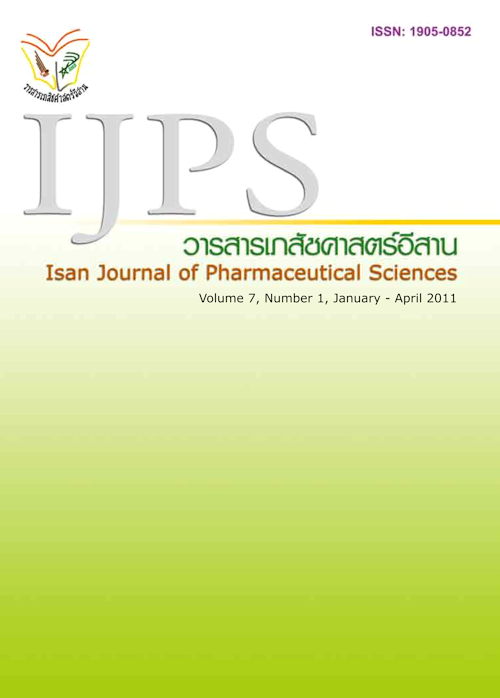The Explanatory Model of Asthma in Perspective of Patients
Main Article Content
Abstract
Introduction: The Explanatory Model can be used to conceptualize health care systems, disease and illness that can be related to health belief, culture, experience and health behavior. The main objective of this study was to determine the explanatory model of asthma for the perspective of patients. Method: For process of data collection, this study used a qualitative method. A purposive sampling technique was used to select 21 asthma patients and 12 caregivers from May to September 2010. In-depth interviews and focus group discussions were used to elicit data from key informants. Result: Patients and caregivers use asthma symptoms to name asthma disease in local language. Patients belief that weakness of the lungs, pollutants and humidity cause asthma. Patients describe asthma symptom such as coughing, stingy phlegm, wheezing, breathlessness, chest tightness, and diffculty speaking. Patients belief that asthma causes death so they have health-seeking behavior for treatment both mainstream and alternative medicine. Some patients hold hot stones or sit beside an open fre for relief as an alternative treatment without using medication. Conclusion: The explanatory model of asthma from the patient’s perspective is based on experience and belief, although they all got information about the disease from health care providers.
Article Details
In the case that some parts are used by others The author must Confirm that obtaining permission to use some of the original authors. And must attach evidence That the permission has been included
References
Adams S, Pill R, Jones A. Medicine, Chronic illness and identity: the perspective of people with asthma. Social Science & Medicine [serial online] 1997; 45(2): 189 – 201.
Aidoo M, Harpham T. The explanatory models of mental health amongst low-income women and health care practitioners in Lusaka, Zambia. Health Policy and Planning [serial online] 2001; 16(2): 206-213.
Arcury TA, Skelly AH, Gesler WM, Dougherty MC. Diabetes meanings among those without diabetes: explanatory models of immigrant Latinos in rural North Carolina. Social Science & Medicine [serial online] 2004; 59(11): 2183-2193.
Bojarus A, Potip K, Tongsian H, Posri P. Treatment Outcome among Asthma Patients in the Asthma Clinic, Kanthararom Hospital, Sisaket Province. Journal of Health Systems Research 2008; 2(1), 550-556.
Boonyarat W. Outcome of a New Model of Pharmaceutical Care for Asthmatic Patients at Nongbualumphu Hospital [Thesis for The degree of Master of Pharmacy in Clinical Pharmacy] Chiangmai: Graduate school Chiangmai Universit; 1994.
Bureau of Policy and Strategy. Thailand Health Profile 2005-2007. Bangkok: Bureau of Policy and Strategy Institute Ministry of Public Health; 2007.
Chapman KR, Walker L, Cluley S, Fabbri L. Topical Reviews Improving patient compliance with asthma therapy. Respiratory medicine [serial online] 2000; 94(1): 2-9.
Clark N, Jones P, Keller S. Vermeire P. Patient factors and compliance with asthma therapy. Respiratory medicine [serial online] 1999; 93(12): 856-862.
Cochrane GM, Horne R, Chanez P. Compliance in asthma. Respiratory Medicine [serial online] 1999; 93(11): 763-769.
Duangdee A. Outcome of an Easy Asthma Clinic, Banphai Hospital, Khonkaen Province. Journal of Health Systems Research 2007; 1(2), 45-50.
Global Initiative for Asthma (GINA). Global strategy for asthma management and prevention [online] 2008. [cited 2009 July 19]. Available from http://www.ginasthma.org.
Handelman L, Rich M, Bridgemohan CF, Schneider L. Understanding Pediatric Inner – City: An Explanatory Model Approach. Journal of Asthma [serial online] 2004; 41(2): 167–177.
Hardie GE, Janson S, Gold WM, Carrieri-Kohlman V, Boushey HA. Ethnic Difference: Word Descriptors Used by African-American and White Asthma Patients During Induced Bronchoconstriction. CHEST [serial online] 2000; 117(4): 935-943.
Helman CG.Culture, Health and illness : an Introduction for health Professionals. 2nd ed. Great Britain: Redwood Press; 1990.
Horne R, Weinman J. Patients’ beliefs about prescribed medicines and their role in adherence to treatment in chronic physical illness. Journal of psychosomatic research [serial online] 1999; 47(6): 555-567.
Jitsaree L. Efficacy of Treatment in the Asthma Clinic of Bang-Pa-In Hospital. Journal of Health Systems Research 2008; 2(3), 771-776.
Kleinman A. Patients and healers in the context of culture: An Exploration of the Borderland between Anthropology, Medicine, and Psychiatry. Berkley, Los Angeles and London: University of California Press; 1980.
Loignon C, Bedos C, Sévigny R, Leduc N. Understanding the self-care strategies of patients with asthma. Patient Education and Counseling [serial online] 2009; 75(2): 256-262.
Lurie A, Marsala C, Hartley S, Bouchon-Meunier B, Dusser D. Patients’ perception of asthma severity. Respiratory medicine [serial online] 2007; 101(10): 2145-2152.
Nagmai L. Efficacy of an Asthma Clinic Operation in Danchang Hospital. Journal of Health SystemsResearch2007; 1(2): 113-118.
Pavasudthipaisit A, Awiphan R, Niwatananan K, et al.An Integration of the Explanatory Model for caring diabetic patients by clinical pharma-cist. Thai Journal of Hospital Pharmacy 2009; 19(1); 28-42.
Peterson JW, Sterling YM. “Growin” out of it”: An Explanatory of childhood Asthma by African American Families. In: Chesnay MD, editor. Caring for the Vulnerable: Perspective in Nursing Theory, Practice, and Research. Sud-bury, Mass: Jones and Bartlett; 2005. 143-152.
Scherman MH, Löwhagen O. Drug compliance and identity: reasons for non-compliance: Experiences of medication from persons with asthma/allergy. Patient Education and Counseling [serial online] 2004; 54(1): 3-9.
Sirimai P. Assessment of Quality of Care and Outcome for Adult Asthmatic Patients in Thailand. Bangkok: Health Systems Research Institute Ministry of Public Health; 2006.
The Commitee for Revision of Guidelines for the diagnosis and management of asthma 2008. Guidelines for the Health Service: To care Asthmatic patients 2008. Bangkok: Srimuangkarnpim: 2008.
The Thoracic Society of Thailand. Guidelines for the diagnosis and management of asthma inThailand(For Adults revised version). Bangkok: Krichwan Ink; 2004.
Williams LK, Joseph CL, Peterson EL, Wells K, Mingqun W, Chowdhry VK, et al. Patients with asthma who do not fill their inhaled corticosteroids : A study of primary nonadherence. Journal of allergy and clinical immunology[serial online] 2007; 120(5): 1153-1159.


